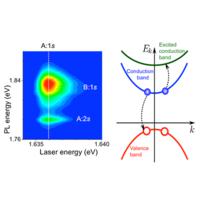当前位置:
X-MOL 学术
›
Phys. Rev. X
›
论文详情
Our official English website, www.x-mol.net, welcomes your feedback! (Note: you will need to create a separate account there.)
Exciton States in MonolayerMoSe2andMoTe2Probed by Upconversion Spectroscopy
Physical Review X ( IF 12.5 ) Pub Date : 2018-09-18 , DOI: 10.1103/physrevx.8.031073 B. Han , C. Robert , E. Courtade , M. Manca , S. Shree , T. Amand , P. Renucci , T. Taniguchi , K. Watanabe , X. Marie , L. E. Golub , M. M. Glazov , B. Urbaszek
Physical Review X ( IF 12.5 ) Pub Date : 2018-09-18 , DOI: 10.1103/physrevx.8.031073 B. Han , C. Robert , E. Courtade , M. Manca , S. Shree , T. Amand , P. Renucci , T. Taniguchi , K. Watanabe , X. Marie , L. E. Golub , M. M. Glazov , B. Urbaszek

|
Transitions metal dichalcogenides (TMDs) are direct gap semiconductors in the monolayer (ML) limit with fascinating optical and spin-valley properties. The strong optical absorption of up to 20% for a single ML is governed by excitons, electron-hole pairs bound by Coulomb attraction. Excited exciton states in and monolayers have so far been elusive because of their low oscillator strength and strong inhomogeneous broadening. Here, we show that encapsulation in hexagonal boron nitride results in an emission line width of the exciton below 1.5 meV and 3 meV in our and monolayer samples, respectively. This allows us to investigate the excited exciton states by photoluminescence upconversion spectroscopy for both monolayer materials. The excitation laser is tuned into resonance with the transition, and we observe emission of excited exciton states up to 200 meV above the laser energy. We demonstrate bias control of the efficiency of this nonlinear optical process. We discuss the origin of the upconversion effect. Our model calculations suggest an exciton-exciton (Auger) scattering mechanism specific to TMD MLs involving an excited conduction band, thus generating high-energy excitons with small wave vectors. The optical transitions are further investigated by white light reflectivity, photoluminescence excitation, and resonant Raman scattering, confirming their origin as excited excitonic states in monolayer thin semiconductors.
中文翻译:

上转换光谱探测单层MoSe2和MoTe2中的激子态
过渡金属二卤化物(TMD)是单层(ML)范围内的直接间隙半导体,具有令人着迷的光学和自旋谷特性。单个ML的高达20%的强光吸收受激子和库仑吸引作用约束的电子-空穴对的控制。激发态 和 迄今为止,由于其低的振荡器强度和强烈的不均匀展宽,单层一直难以捉摸。在这里,我们表明六方氮化硼中的包封导致发射线宽度为 低于1.5 meV和3 meV的激子 和 单层样品。这使我们能够通过光致发光上转换光谱法研究两种单层材料的激发激子态。激发激光被调谐到与跃迁,我们观察到激发激子态的发射比激光能量高200 meV。我们展示了这种非线性光学过程效率的偏置控制。我们讨论上转换效应的起源。我们的模型计算表明,TMD ML涉及激发的导带,因此存在一种特定于TMD ML的激子-激子(Auger)散射机制,从而生成了具有小波矢的高能激子。通过白光反射率,光致发光激发和共振拉曼散射进一步研究了光学跃迁,从而确认了它们的起源是单层薄半导体中的激发激子态。
更新日期:2018-09-19
中文翻译:

上转换光谱探测单层MoSe2和MoTe2中的激子态
过渡金属二卤化物(TMD)是单层(ML)范围内的直接间隙半导体,具有令人着迷的光学和自旋谷特性。单个ML的高达20%的强光吸收受激子和库仑吸引作用约束的电子-空穴对的控制。激发态 和 迄今为止,由于其低的振荡器强度和强烈的不均匀展宽,单层一直难以捉摸。在这里,我们表明六方氮化硼中的包封导致发射线宽度为 低于1.5 meV和3 meV的激子 和 单层样品。这使我们能够通过光致发光上转换光谱法研究两种单层材料的激发激子态。激发激光被调谐到与跃迁,我们观察到激发激子态的发射比激光能量高200 meV。我们展示了这种非线性光学过程效率的偏置控制。我们讨论上转换效应的起源。我们的模型计算表明,TMD ML涉及激发的导带,因此存在一种特定于TMD ML的激子-激子(Auger)散射机制,从而生成了具有小波矢的高能激子。通过白光反射率,光致发光激发和共振拉曼散射进一步研究了光学跃迁,从而确认了它们的起源是单层薄半导体中的激发激子态。



























 京公网安备 11010802027423号
京公网安备 11010802027423号